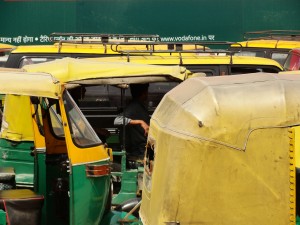
Throughout cities in India (est. population of ~1.155 billion), high levels of pollution, congestion, energy use, noise, and traffic fatalities coupled with rising incomes, motor vehicle ownership, urbanization, and land use sprawl result in some troubling trends. Currently, there are an estimated 72.7 million motor vehicles in India, with 30.3% of households in urban areas having motorized vehicle “ownership” (the majority of which are two-wheelers: ~70%)[1]. These numbers appear relatively low in comparison to the United States (est. population of ~311 million), where there are almost 255.9 million registered motorized vehicles[2] and only 8.7% (9.8 million) of all households lacking vehicle[3] ownership; however, relative to countries of similar per capita incomes (e.g. Vietnam, Nigeria, Nicaragua), the percentage of households in India’s urban areas with motor vehicles is very high. From 1990 to 2007, the total number of cars on the road in India roughly tripled (while increasing tenfold in China)[4] and current trends predict a doubling of vehicle population (including scooters, motorcycles and cars) in many rapidly developing Indian cities every four to six years. Currently, even with “low” levels of car ownership, many Indian cities experience paralyzing traffic congestion (some of the worst in the world) and accommodating more cars will be costly, generating: 1) tremendous demands for new infrastructure, land, road space, materials, energy; 2) higher traffic fatality risks; and 3) worsening air quality, resulting in severe health impacts and deteriorating quality of life for many communities.
Efficient and clean public transit systems, such as the Janmarg bus rapid transit system in Ahmedebad[5] and the Delhi Metro Rail, meanwhile demonstrate viable alternatives to automobile transportation in Indian cities – ones that can help leverage mitigation of greenhouse gas emissions, creation of new jobs, reduction of respiratory illnesses, improvements in access to various services for the urban poor, and creation of resilient systems that reduce vulnerabilities to oil shocks and/or natural disasters (e.g., cyclones, floods). Although complex transportation and land-use system challenges mean that public transport cannot solve all of growing India’s congestion problems, carefully planned improvements to existing transit services and the creation of new transit-oriented communities near affordable housing offers a win-win (with economic, environmental, and health co-benefits) for cities like Delhi, Mumbai, Chennai, and even smaller cities rapidly growing like Coimbatore in Tamil Nadu and Rajkot in Gujarat.
At the federal level, two initiatives launched by the Indian government in 2005, the Jawaharlal Nehru National Urban Renewal Mission (JNNURM) and National Urban Transport Policy (NUTP), are incentivizing city investment in bus rapid transit systems (BRTs). As of April, 2010, 19 BRT corridors across 10 cities had been sanctioned and funded under the JNNURM. Meanwhile, India’s state-run railway network is also expanding, with a $USD 56 billion five-year investment program launched in 2008[6].
Barriers to further incentivizing non-motorized and public transportation are the existing transportation priorities of municipal planners, which are mainly focused on roadway investments to meet to growing automobile demand, and extreme heat, which is expected to increase as a result of climatic changes and urban sprawl. In the past few summers in New Delhi (population: 16 million), temperatures have reached well over 44°C (or 112°F), and it is expected that the frequency of these extreme temperature days will very likely increase in the years ahead.
India faces some hard questions going forward: Are BRTs really a feasible option for large and growing cities? What steps can be taken to ensure that these mass transit investments will pay off? How can BRTs help facilitate different and potentially more sustainable land-uses than we would see if India continues along its current “road-building” path? How can BRTS or other public transit help on a 112°F day when there’s the option to be in an air-conditioned car? What new incentives, strategies, and shifts in conventional thinking will be needed to solve congestion problems? And how can engineers, planners, economists, policy actors, public health and behavioral scientists all come together to shape the future of urban mobility in India for the rich, the poor, and those in between? Finally, can more ambitious investments in transit and other transport options – which have the ability to move people of all ages, (dis)abilities, and income levels – provide a large enough shift to slow the India motorization phenomena while helping global transport, energy, and climate change sectors delay and better prepare for sustaining a planet that could reach two billion cars[7] in the upcoming decades?
-Joshua Sperling, National Science Foundation IGERT Fellow in Sustainable Urban Infrastructure, University of Colorado Denver
[1]http://web.worldbank.org/WBSITE/EXTERNAL/COUNTRIES/SOUTHASIAEXT/EXTSARREGTOPTRANSPORT/0,,contentMDK:20694248~pagePK:34004173~piPK:34003707~theSitePK:579598,00.html
[2]http://www.bts.gov/publications/transportation_statistics_annual_report/2003/html/chapter_02/vehicle_ownership_and_availability.html
[3]http://www.bts.gov/publications/transportation_statistics_annual_report/2008/html/chapter_04/table_04_03.html
[4]Pucher, 2007 Urban Transport Trends and Policies in China and India: Impacts of Rapid Economic Growth
[5] http://www.itdp.org/index.php/news/detail/ahmedabad_wins_2010_sustainable_transport_award/
[6] http://news.bbc.co.uk/2/hi/business/7265287.stm
[7] http://www.amazon.com/exec/obidos/ASIN/0195376641/npr-5-20